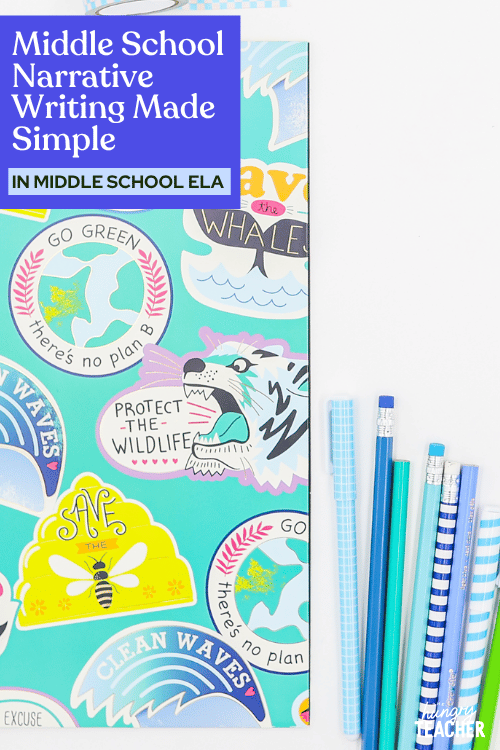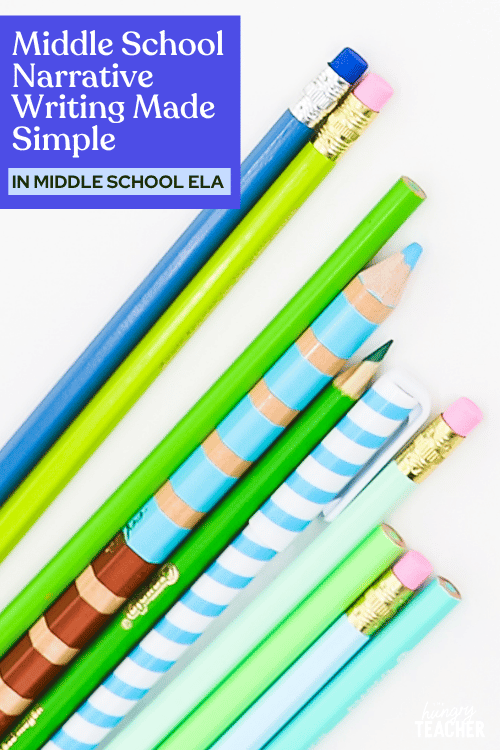hey friend!
I'm Martina.
I provide practical, time-saving strategies that actually work—so you can engage your students, teach effectively, and reclaim your time from the exhausting planning-grading cycle.
Browse Our ELA Resources
Middle School Narrative Writing Made Simple
For the first few years that I taught, I hated teaching narrative writing to my middle schoolers. Writing days meant endless stress. Students were constantly calling my name. There were nonstop problems. Students hardly made progress with their narrative essays because they didn’t know what to do or were waiting on me to help them. It was terrible!
Fast forward to the present day, I look forward to narrative writing in my classroom. Writing days often mean a lot of productivity and a rather calm classroom. So, what has changed to transform my opinion on writing days?
I began using reference sheets! Throughout this blog, I’ll share how reference sheets for narrative writing are the way to a simple, productive middle school writing unit.

What is narrative writing?
Before I dive too deep into reference sheets, I want to make sure we are on the same page with narrative essays. A narrative essay can be fiction or nonfiction. Sometimes narratives are called short stories or personal narratives. Essentially, narratives are stories.
What makes narrative writing so exciting for students is the opportunity to create a detailed story. Whether the story is fiction or nonfiction, the space to add imagery, details, and imagination are huge perks for more creative students.
The downside is that many students can get lost in narratives. For some, the ability for your creativity to run wild can leave them with option paralysis. For others, they are so excited to tell their story that they leave every grammar and language rule behind.
What are reference sheets?
As I spoke about, writing used to be a chaotic experience for me (and my students). I decided I either had to clone myself to help more kids or find a way for the kids to help themselves (and since cloning wasn’t an option…). Enter the reference sheets.
A reference sheet is probably what it sounds like. They are pages of notes that students can reference for information. You can actually snag ALL my narrative writing reference pages in a cute booklet FOR FREE by clicking HERE.

The goal is that students use these reference pages when they are stuck or have questions during writing. Instead of you being the first person they get information from, the reference sheet becomes their guide. Kinda like that three before me rule.
These reference guides can have anything you want in them, but you want to stick to key, need-to-know information. For narrative essays, this might look like dialogue, writing an introduction / body / conclusion, editing, and so forth. The reference page should be easy to find and read through. It can even contain examples for students to reference and model their essay after.
How Reference Sheets Saved my Writing Unit
Before reference sheets, I could easily earn 10,000 steps walking circles around my classroom. I never actually sat down with a student for long to dig deep into their writing. Instead, I was just trying to keep students motivated to write or answer questions like, “Do I put a comma here?”
With reference sheets, my writing routine changed. Here’s what my class now looks like during narrative writing.
- Mini-lesson: I introduce the skill I want students to work on today with their writing. For example, if I want students to add dialogue or edit dialogue in their narrative today, I will provide a mini-lesson on punctuation and placement of dialogue. During the mini-lesson, students will have a reference sheet I made, and we will use it to move through the mini-lesson.
- Example: Next, I will provide some sort of example to my students to model the skill. This example may also be on the reference page I gave them, or it might not. I’ll engage students in the example, and ask them to apply the skill.
- Independent Work: Students are now familiar with their specific skill and task of the day, and they have a go-to guide if they need it. Students are then challenged with working diligently to apply the new skill to their own writing. If they get stuck, they will consult the reference sheet before me.
- Conferences: While independent workers use their reference sheets to edit their writing, certain students will meet with me. Having the majority of the class work independently and not depend on me to answer so many questions frees up time to reteach, clarify, or simply talk to students about their writing. Often I do these in small groups to make use of time.
- Exit Ticket: Lastly, I try to engage students in some type of sharing. They can share something they are proud of, something they wrote, or a question they have.
This type of structure on a writing day would not be possible without my students being able to help themselves and have quick access to information. It’s all thanks to a reference page. Wanna learn more about how I plan my narrative writing units? Check out my other blog post!
If you want to try out reference pages in your own classroom, I have a narrative writing reference booklet ready with all the essential information your students will need.. It will save you time and sanity on your writing days. You can check out that resource here. It includes skills such as plot, details, transitions, dialogue, and much more.

I hope you try out reference pages of your own to see the magic happen in your classroom! If you aren’t sure where to start, try the writing day schedule I wrote about above. You can tweak it for your own students.
Want a sneak peek at teaching The Hungry Teacher way—with support, structure, and strategy?
When you join the waitlist for The Hungry Teacher’s Hub membership, you get three free classroom-ready resources: a theme unit, an expository writing unit, and a grammar unit introducing mentor sentences. Plus, you’ll get immediate access to a selection of exclusives from the Hub, including editable sub plans, pacing guides, and more.
No strings attached. Just resources you can use right now—and a heads-up when the Hub opens.
3 Free Middle School ELA Units—yours to keep!
JOIN THE WAITLIST + A FREE GIFT
Where to next, line leader?
Welcome to The Hungry Teacher! We create resources that are easy to use, practical, and get results. Teach with confidence—and make it home before dinner.
xo, the hungry teacher